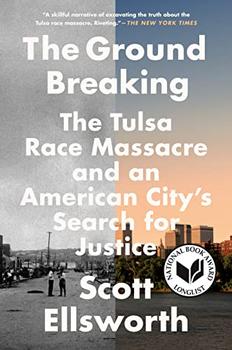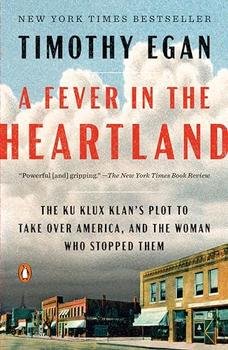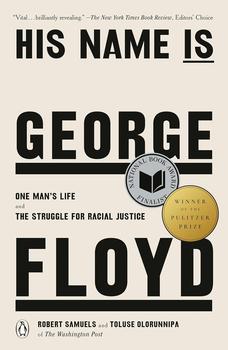Summary | Excerpt | Reviews | Beyond the book | Read-Alikes | Genres & Themes | Author Bio

An American City and Its Search for Justice
by Scott EllsworthWhile there has been a concerted effort in recent years to educate the nation about what happened during the Tulsa Race Massacre from May 31-June 1, 1921, the search for the whole truth, including the location of many of the victims' remains, has been an arduous process. In Death in a Promised Land (1992), Scott Ellsworth, a Tulsa, Oklahoma native and current professor of Afro-American and African Studies at the University of Michigan, detailed the events of the massacre. In The Ground Breaking, he explores the history of the aftermath, from the official and unofficial coverup to the quest to bring the events to the light of day.
The book is divided into three sections. Part One briefly recounts the events of May 31-June 1, 1921. The massacre started when a mob of white men, spurred on by false reports that a Black man assaulted a white woman, attempted to storm the Tulsa Courthouse to lynch the accused man. A group of Black residents went to the courthouse as well, hoping to thwart the lynching. This further infuriated the white mob, which eventually grew to thousands, and they marched on Greenwood, Tulsa's vibrant Black neighborhood. Over the course of two days, the mob killed hundreds of Greenwood residents and laid waste to most of the structures. After the initial flurry of headlines, Ellsworth explains, the massacre quickly disappeared from public discourse. However, with the rise of the Civil Rights movement in the 1960s, there grew an effort by activists and academics alike to bring the Tulsa Race Massacre out of the shadows.
In Part Two, Ellsworth recalls the bombing of the Alfred P. Murrah Federal Building in nearby Oklahoma City in 1995, which killed 168. At the time, commentators called it the worst act of domestic terrorism in U.S. history. Yet, many noted that the state had seen a far bloodier act of terrorism, and this brought renewed national attention to the Tulsa Race Massacre. For some, this was not only an opportunity to educate the public, but also a chance to try to right the wrongs from 1921, and city and state government officials struggled to find the best way to deal with the history and its implications. Ellsworth goes on to discuss the emphasis on finding the remains of the uncounted victims of the massacre. Given the paucity of documented evidence, either deliberately erased or misplaced, those efforts proved especially difficult. Meanwhile, political factions battled over how to address the massacre and what, if any, reparations were due to the survivors.
In Part Three, Ellsworth blends past and present events, recounting Greenwood's efforts to rebuild after 1921 and the rise of Tulsa mayor T. Bynum, elected in 2016, who took a leading role in uncovering the buried past of the massacre and finding the remains of the victims. Ellsworth's account of how a group of historians, archeologists, forensic scientists and political figures worked together to achieve this goal is skillfully intertwined with recent sociopolitical events, from the contentious 2016 and 2020 presidential elections to the increased publicity related to police brutality against Black Americans. With the exacerbation of racial tensions after the death of George Floyd in May 2020, along with a widely publicized episode of the HBO series Watchmen (see Beyond the Book), the Tulsa Race Massacre reentered the public consciousness.
Overall, this is an engaging and well-researched work about the long-term impact of the Tulsa Race Massacre. Given that much of the primary information disappeared over the years, it is remarkable how much Ellsworth found. He interviews those who survived the massacre and their relatives who want to bring to light the events long covered up, along with political, academic and media figures who, like him, worked tirelessly over months and years to chronicle the massacre's impact over the past century. However, Ellsworth also gives time to those who did not support the efforts for Tulsa to face its past because they did not want to deal with the pain and shame. While Ellsworth does not personally support their viewpoint, giving voice to this level of resistance paints a more comprehensive picture. The subject matter can be difficult to study, especially for those who grew up in and have a deep association with Tulsa, like the author, but it is important to learn and remember what happened not only over those two days in 1921, but in the century since.
![]() This review was originally published in The BookBrowse Review in June 2021, and has been updated for the
June 2022 edition.
Click here to go to this issue.
This review was originally published in The BookBrowse Review in June 2021, and has been updated for the
June 2022 edition.
Click here to go to this issue.

If you liked The Ground Breaking, try these:

by Timothy Egan
Published 2024
A historical thriller by the Pulitzer and National Book Award-winning author that tells the riveting story of the Klan's rise to power in the 1920s, the cunning con man who drove that rise, and the woman who stopped them.

by Robert Samuels, Toluse Olorunnipa
Published 2024
A landmark biography by two prizewinning Washington Post reporters that reveals how systemic racism shaped George Floyd's life and legacy - from his family's roots in the tobacco fields of North Carolina, to ongoing inequality in housing, education, health care, criminal justice, and policing - telling the singular story of how one man's tragic ...
Your guide toexceptional books
BookBrowse seeks out and recommends the best in contemporary fiction and nonfiction—books that not only engage and entertain but also deepen our understanding of ourselves and the world around us.